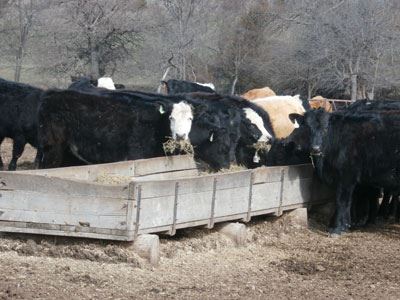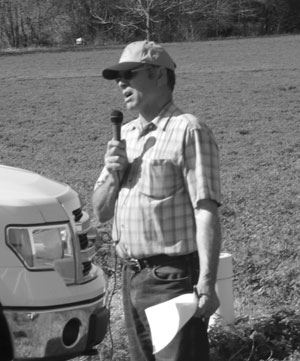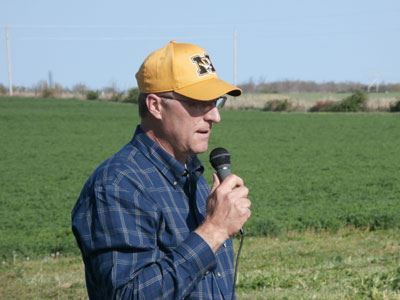|
Beef Cattle And Alfalfa Do Mix Profitably
MT. VERNON, MO.
For many years, beef cattle producers have been under the impression that alfalfa was too expensive to feed to their cattle, especially their cows.
“More recently cows have become pretty valuable and alfalfa, the queen of forages, just might fit a producer’s supplemental feeding plans,” said Eldon Cole, a livestock specialist with University of Missouri Extension.
Attendees on the Extension tour in late April to the Glenn and Toni Obermann Farm near Monett, saw how quality alfalfa is produced. The former dairy producers sold their dairy herd and now sell their alfalfa to dairies, horse owners and increasingly to beef farmers.
Glenn experimented this past winter with caring for stocker steers for a neighbor while feeding them silage and alfalfa hay at his farm. Even though the winter weather was exceptionally tough for southwest Missouri, the six-weight steers gained 2.10 pounds per day.

Stocker steers that Obermann fed for a neighbor this winter enjoy their alfalfa hay.
During the tour, tips were given on alfalfa management from seeding to harvest. Speakers included Glenn Obermann, David Moore with MFA, Inc., Ben Fizette of W-L Alfalfa, Tim Schnakenberg and Eldon Cole who are both with University of Missouri Extension and Bruce Knoernschild of Dupont Crop Protection.

Glenn Obermann shares his experience with farmers who attended
the tour to learn about production and feeding of alfalfa.

Tim Schnakenberg discusses alfalfa management with an excellent stand in the background at the tour.
“The tour was designed to spark interest in raising more high-quality alfalfa in southwest Missouri to supplement the abundant grass pasture and hay, primarily fescue, produced in the area,” said Cole.
Alfalfa will average close to 20 percent crude protein and 60 percent total digestible nutrients (TDN). A fifth cutting from 2013 that was used for seating at the tour tested 27 percent protein and 69 percent TDN.
“Alfalfa production is not for every farm due to soil type, labor availability, hay equipment and herd size,” said Cole.
However, it is recommended that every beef operation consider buying some alfalfa hay or haylage during the haying season when prices are competitive. Remember that covered storage areas for alfalfa hay is required.
“As for planning the quantity of alfalfa to raise or buy, you might consider feeding adult cows an average of five pounds per day during low-quality forage feeding,” said Cole.
Nursing calves thrive on good alfalfa when fed as a creep feed. Stocker intake varies with the basic ration, cattle weight and the desired rate of gain. Cole says it tends to run in the five to seven pounds daily range.
“Many farmers feed alfalfa on alternate days or every third day. May times it depends on the labor and traveling distance to the feeding area,” said Cole.
After the tour, Cole said several attendees told him they came thinking they would try to grow alfalfa. But after hearing the speakers they concluded it would be better to buy their alfalfa from growers.
“Hopefully, more growers will step forward and raise more acres of alfalfa in this area to supplement the area’s beef cattle,” said Cole. ∆
|
|